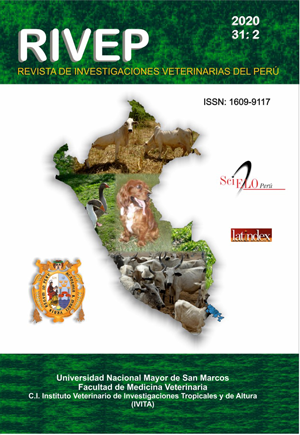Morphology of the K’ara llama (Lama glama) of Checacupe, Cusco, Peru
DOI:
https://doi.org/10.15381/rivep.v31i2.17855Keywords:
zoometry, sex, age, camelids, measurementAbstract
The morphology of 284 K’ara llamas was determined through biometric measurements and body weight based on sex and age factors. The animals were from breeder organizations in the Checacupe district of the Cusco Region, Peru. The measurements were grouped into cephalic, body and trunk heights, cane perimeter and body weight. The analysis was carried out in a 2x5 factorial arrangement (2 sexes, 5 ages) under a complete randomized design. At head level, head length is the only one that contributes to sexual dimorphism (p<0.05). Head height showed greater value, attributable to the presence of an elongated and upright neck. Body lengths show sexual dimorphism and have different growth and development. Male neck measurements were greater (p<0.05), except for the length of the neck. At the thorax level, the thoracic perimeter and depth were greater in males (p<0.05). Each morphological measure presents different magnitudes of increments; especially depending on the age category. The body weight shows differences for the sex and age factor (p<0.05), and in the current environmental conditions, the K’ara llamas can reach 100 kg. The body weight presents a great phenotypic heterogeneity, which constitutes an indicator of the diversity in the growth, adaptability and feeding efficiency of the animal. Based on this, it can be affirmed that the K’ara breed presents aptitudes for meat production and as a cargo transport animal, consistent with historical data; and there is a manifest sexual dimorphism and a relatively fast growth rate.
Downloads
Downloads
Published
Issue
Section
License
Copyright (c) 2020 Jesús E. Quispe Coaquira, Luis Dueñas Gayona, Víctor Bustinza Choque, Roger Machaca Machaca, Nicky A. Bolívar Villegas, Virgilio Machaca Machaca

This work is licensed under a Creative Commons Attribution-NonCommercial-ShareAlike 4.0 International License.
AUTHORS RETAIN THEIR RIGHTS:
a. Authors retain their trade mark rights and patent, and also on any process or procedure described in the article.
b. Authors retain their right to share, copy, distribute, perform and publicly communicate their article (eg, to place their article in an institutional repository or publish it in a book), with an acknowledgment of its initial publication in the Revista de Investigaciones Veterinarias del Perú (RIVEP).
c. Authors retain theirs right to make a subsequent publication of their work, to use the article or any part thereof (eg a compilation of his papers, lecture notes, thesis, or a book), always indicating the source of publication (the originator of the work, journal, volume, number and date).



